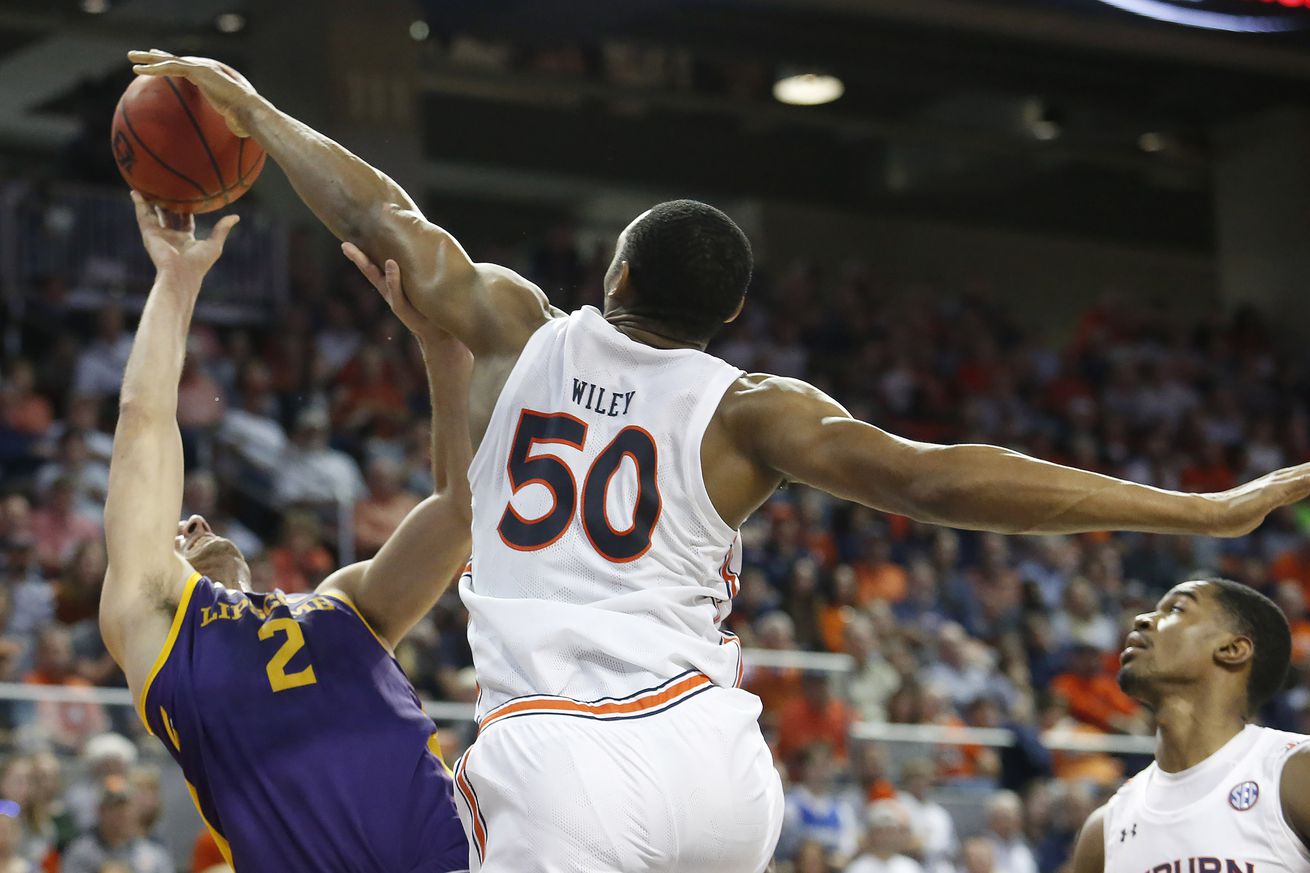 John Reed-USA TODAY Sports
John Reed-USA TODAY Sports
Twelve games, twelve wins. What’s left to know?
After last season’s meteoric rise to the top of college basketball, it was safe to assume Auburn might be due for a little regression come this fall. Not only was Bruce Pearl’s squad playing out of its mind for over a month, but the Tigers lost their top 3 contributors and two more key role players. Sure, Bruce was building a national program on the Plains, but no rational fan thought we’d be right back at the top right away this year.
Yet, here we are. Auburn’s win over Lipscomb last night capped off an undefeated non-conference slate to start the season 12-0, leaving them as just one of two undefeated teams in college basketball, along with SDSU. While the schedule hasn’t been stacked with highly ranked teams, Auburn has still taken down six KenPom top 100 teams, including four away from Auburn Arena. But how have the Tigers gotten there? Let’s look more closely at the advanced box scores!
NON-CONFERENCE ADVANCED BOX SCORES
As a reminder, season stats can be found on the “Season” worksheet, while individual game box scores can be found in subsequent tabs. You can safely ignore the “Season Prev” worksheet, that’s mostly an accounting thing for me. I’ve pulled the following from the “Season” worksheet.
FOUR FACTORS
/cdn.vox-cdn.com/uploads/chorus_asset/file/19562398/4factors.jpg)
- eFG% - This has been Auburn’s biggest advantage so far. In most of its games, the Tigers have just been better shooters than their opponents. Most of Auburn’s 9.1% cushion in eFG% over opponents comes from their dominance at the rim, where Auburn shoots 57.5% to opponents’ 45.6%.
- FTA/FGA - This could be a huge advantage for Auburn, but poor free throw shooting has limited that. Still, Auburn has a huge lead in free throws attempted over its opponents, which has mitigated the Tigers’ failures at the free throw line. Ever since Bruce brought in a sports psychologist to help with free throws, though, Auburn’s shown some improvement from the line, going 70.3% over the last three games. Hopefully that trend continues into conference play.
- TO Rate - Turnovers have not been kind to Auburn. In five of the last six games, Auburn has been sitting over 18% on turnover rate, which is just too high to live with. This despite the fact that J’Von McCormick has a personal turnover rate of just 4%. He’s been fantastic running the point, and while Samir Doughty is certainly not a bad option backing him up, the man with the headband is certainly a little more loose with the ball, leading to some turnovers. A lot of the turnovers also seem to have come when anyone except for J’Von tries to force the ball down low to Austin Wiley.
- ORB% - This team struggled early in the season getting to offensive boards, but has come on strong as of late. Most of that can be attributed to Wiley, who’s bringing home 17.4% of the possible offensive rebounds when he’s on the court. Sure, some of those are his own put backs after a miss. But the next best offensive rebounder on the team has been Issac Okoro, who clocks in at around 8%. Wiley’s dominance on the glass has also cut down opponents’ chances for offensive rebounds, as Auburn has limited opponents to under 30% offensive rebounding this season.
INDIVIDUAL STATS
/cdn.vox-cdn.com/uploads/chorus_asset/file/19562847/Individual.jpg)
/cdn.vox-cdn.com/uploads/chorus_asset/file/19562849/Usage.jpg)
- If you’ve watched Austin Wiley, especially in the last month, you know he’s been a cheat code against most of these overmatched mid-majors. In just 20 min/game, he’s a half a rebound away from averaging a double-double, and he’s been one of the best rebounders in the country on both ends of the court. His offensive game can be infuriating at times, but because he gets to the line so much, he’s taken slightly more than one free throw for every shot he attempts from the field. What that means is that on average when Wiley shoots, it’s effectively a three-point attempt. With his free throw shooting on an upwards trend, I’m perfectly happy with Wiley being tied for the highest Usage% on the team.
- One of the trends I’ve been curious about has been Anfernee McLemore abandoning two-point attempts. He leads the team in 2P%, hitting nearly 70% of his attempts, but four games he’s just 2 of 6 from inside the arc. I’m sure there’s an offensive strategy Bruce is employing when Anfernee is on the court in place of Wiley that is leading to this, but I couldn’t tell you what it is. Anfernee’s hitting 35% of his 3’s this season, good for third on the team, but I would still keep an eye on this for now.
- Jamal Johnson has risen to the top of the ORtg leaderboard thus far. Highlighted by a 4 of 5 from three performance against Lipscomb last night, he’s sporting the best three-point shooting rate (44%) and free-throw shooting rate (76%) on the team right now. He may look a little bit like early Bryce Brown, where if the threes aren’t falling then he’s a non-factor, but up to this point in the season he’s been Auburn’s best weapon from beyond the arc. He’s also been Auburn’s best contributor from off the bench (if we’re considering Wiley and Mac co-starters), giving Bruce another guard he can trust with 15+ minutes per night.
- J’Von McCormick has been filling the stat sheets every single night. Even though he’s shown he can score in bunches (52 points in a three-game stretch recently), he’s still passing the ball on roughly 70% of his touches. He’s shown a true knack for helping create in this offense, which is something I didn’t think I’d be saying about him this time last season.
- One of this team’s strengths is the efficiency on offense. Remember, Usage% is the % of possessions a player is responsible for ending (via shooting, turnover, or assist) while he’s on the floor, and Floor% is the % of the previously described possessions that end in points. So a player with a higher Usage% had better have a higher Floor% than his teammates, otherwise those teammates should get the ball and not him. Of the nine guys that play serious minutes, all of them are between 17-24% usage, with each of the four bench players at 17% usage. That makes sense, though, as each of those four (Mac, Johnson, Flanigan, and Cambridge) have a lower Floor% than the guys with more usage. The only player I see being misused is Issac Okoro, who has a team-best 44% Floor% but is fourth on the team in Usage%. Such is life for a freshman, though.
THE ISSAC OKORO EFFECT
Another thing I’ve been keeping an eye on this season is something I’ve dubbed the “Issac Okoro Effect”. The Issac Okoro Effect is the fact that opponents’ top performers for the season have been playing significantly worse against Auburn. I think this is largely due to Issac Okoro’s defense, as he’s usually paired up against the opponents best offensive players, but in practice this is a credit to the entire Auburn team’s defense.
To measure this, I took each team’s leading scorer for the season and compared their performance against Auburn to their season average (not including the Auburn game).
/cdn.vox-cdn.com/uploads/chorus_asset/file/19563141/IOE_12_30_19.png)
Up until the last few games, the Effect was in full force. Teams’ leading scorers were over 5 points worse against Auburn than they were the rest of the season. C.J. Bryce of NCST and Jordan Cohen of Lehigh ended up having good showings in Auburn Arena, but those were games were Issac Okoro played in foul trouble for extended stretches. Through all twelve games, the average difference between performances against Auburn and against everyone else is 2.45 points. It’s possible the last few games have been a course correction after a small sample size, but I’m certainly going to be keeping an eye on this as conference play kicks off.
from College and Magnolia - All Posts https://www.collegeandmagnolia.com/2019/12/30/21042773/advanced-box-score-non-conference-recap-auburn-tigers-basketball-2019-2020


No comments:
Post a Comment